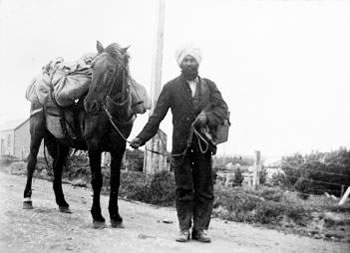 Indians first settled in New Zealand in the late 1800s.
Indians first settled in New Zealand in the late 1800s.
Most of these early migrants came from the regions of Punjab and Gujarat and were temporary labourers.
They numbered only a handful, an estimated 46 persons in 1896 and were listed in occupational statistics as pedlars, hawkers and domestics.
They were also overwhelmingly men.
In 1896, only one Indian woman was listed as resident in New Zealand!
Most of these early migrants did not intend staying here but wanted to earn money before returning home.
Migration increased until 1920, when the New Zealand Government introduced restrictions under a ‘permit system.’ By this time, there were just over 2000 Indians in New Zealand. The number of Indian women had grown to 142, as some of the Indian men living here went home to bring their wives or, if they were single, brides.
But the New Zealand Indian community was still overwhelmingly a society of men.
Many of them lived and worked communally. While a few set up shops, most found work as hawkers, bottle collectors and kitchen hands in the larger towns or as labourers in the market gardens of Otahuhu and Pukekohe.
Others worked building railways or draining the swamps of the Hauraki lowlands.
Anti-Asian sentiment
 Around this time, there was increasing prejudice and fear about Asian migrants.
Around this time, there was increasing prejudice and fear about Asian migrants.
The White New Zealand League emerged in 1926 with the slogan ‘Keep New Zealand a White Man’s Country.’ It found strong support in the press and from local bodies. Indians were criticised for living in shacks and ‘introducing alien views of life and standards of conduct.’ The White New Zealand League warned that the intermingling of Indians with both Pakeha and Maori would result in the ‘half-cast citizen of the future,’ a prospect it regarded with alarm.
In some places where Indians were perceived as ‘taking over,’ prejudices ran deep and lasted a long time. In Pukekohe, Indians were not allowed to join the local growers’ association, some landowners refused to lease them land and they were not allowed into the balcony seats of the picture theatre.
Until 1958, only one barber’s shop in Pukekohe would cut the hair of Indians!
Association formed
The discrimination that Indian migrants encountered and their increased commitment to settling in New Zealand permanently led to the formation of the New Zealand Indian Central Association in 1926.
.jpg) After the introduction of the ‘permit system’ in 1920, the number of new migrants from India dropped. However, of those who did make it here, a greater proportion was women and children. By 1945, families (mostly of shopkeepers and fruiterers) were getting established and marriages of second-generation New Zealand Indians were to become increasingly important.
After the introduction of the ‘permit system’ in 1920, the number of new migrants from India dropped. However, of those who did make it here, a greater proportion was women and children. By 1945, families (mostly of shopkeepers and fruiterers) were getting established and marriages of second-generation New Zealand Indians were to become increasingly important.
But Indian weddings in New Zealand remained rare, even after World War II when more liberal attitudes allowed for easier entry of Indian migrants into New Zealand. Indians tended to settle in concentrated pockets rather than throughout the country.
Punjabis settled in Waipa, Waikato, Otorohanga, and Taumarunui, while Gujaratis settled in Auckland, Pukekohe, and Wellington.
Until the 1980s, over 90% of New Zealand Indians traced their roots back to Gujarat, especially to the Surat district. Most were Hindu. The biggest group (6%) came from Punjab and was usually Sikh.
Today, Indians living in New Zealand are not restricted to the few trades that they subject to earlier. Now few Indians (less than 5%) are involved in agriculture, while nearly a third (33%) are in professional, managerial, and administrative positions. Indians are prominent in a number of sections of New Zealand society, including business, medicine, education, politics, sport, and the arts.
Editor’s Note: The above article appeared in our March 1, 2004 issue.




